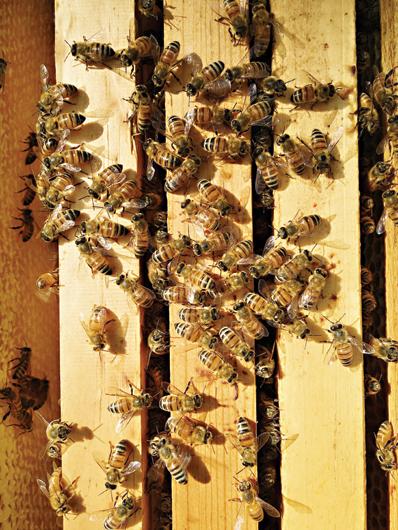I have tucked myself into a bee suit exactly twice in my life.
That first time, more than a dozen years ago now, I had gone to see a Benedictine nun about some bees. It was an excuse to get out of the office, really. I drove up through the Connecticut hills to the Abbey of Regina Laudis in the town of Bethlehem to spend the morning with my husband’s second cousin, once a successful businesswoman, now leading a contemplative life. As part of her contribution to her community – also a working organic farm – she cared for the bees.
Before putting on the thick leather gloves she would need to handle the hives, Mother Deborah Joseph carefully zipped me into my borrowed white coveralls and mesh veil – my own habit for the day. I stayed close to her as I watched her calmly pry open the hives and let the bees adjust to the intrusion. I listened carefully as she talked about the crucial role the bees play in pollinating the vegetables and fruits on the farm, and I watched with wonder as she lifted a frame of honeycomb to show me how the bees store honey for the winter.
Afterward, walking back through the woods to lunch, Mother Deborah Joseph suggested that perhaps there was a greater purpose afoot in my visit to the Abbey. She had sensed somehow that I was carrying a huge burden of stress – not about the bees, but about my office job and life in general. Driving home that day, I knew she was right. I understood for the first time that despite my years as a cooking expert and food magazine editor, I had lost touch with where my food came from. I didn’t even have time to get to a farmers’ market. I desperately wanted to grow food, to take part in the miracle. In a way, therefore, I have the bees to thank for my move to Martha’s Vineyard and my pursuit of farming.

The second time I put on a bee suit was this past September, on a blue-blue-blue-sky Vineyard day, a gentle southerly breeze bending the yellow tips of just-blooming goldenrod on the path out to the orchard at Thimble Farm. I was meeting my friend Randi Baird, who had invited me to come along to check on a new hive she had set up in the spring. Randi has been beekeeping for nine years, and she also started a beekeeping education program through her involvement in Island Grown Initiative.
I pulled on the white smock and helmet that Randi offered me while she lit the little tin smoker that we’d wave over the hive upon opening it. I stood back as she removed the cover and lifted out a frame. She pointed out a male “drone” to me (his chief job is to mate with the queen) and explained that most of the rest of the bees were female worker bees who do all the hard work, flying out of the hive to gather flower nectar to make honey.
“And, uh, how do they make honey?” I asked Randi to remind me.
Randi turned and smiled at me when I asked this – not because it’s such a basic question, but because the answer is so very cool, one of nature’s most amazing feats. After the bees gather the nectar (they suck it up with their long tubular tongues and store it in a special honey stomach), they return to the hive and transfer it to a processor bee, who digests it (sometimes repeatedly) with a special enzyme called invertase that converts the sugar water into a combination of fructose and glucose that helps make honey stable (and ultimately better for you than table sugar). The processor bee regurgitates the nectar into the honeycomb.
But here’s the coolest part: the sugar water is still quite runny at this point so the worker bees use their wings to fan the mixture until the water content is reduced to something around 18 percent. (It starts out at about 80 percent.) Not only is the honey now viscous, but the reduced moisture means it will keep indefinitely. (Honey is believed to be the only food that doesn’t go bad.) The worker bees cap the finished honey with wax secreted from their abdomens.
What amazing creatures. What an honor to spend even a little time outside observing what they do to make the world go round. (I couldn’t grow my vegetables without them.) This time, as I stripped off my bee suit and thanked Randi, I knew I was in the right place.
But short on honey. On the drive home, I detoured for a stop at Cronig’s, where I found two jars of local honey left on the shelves – one from the Island Bee Company and one of Monica’s Artisan Honey. I bought them both to restock my supply for the fall and winter – to drizzle on bitter greens or aged cheese, to toss with sautéed vegetables, to stir into yogurt and fruit, or to make my favorite honey-roasted pears (recipe at right). Or, of course, to stir into my lemon tea to soothe a sore throat. (Honey truly has healing powers, from its antimicrobial ability to heal cuts and sores to its antioxidant flavonoids that can calm scratchy throats and reduce muscle aches.)
The following recipe was originally published along with this article:






